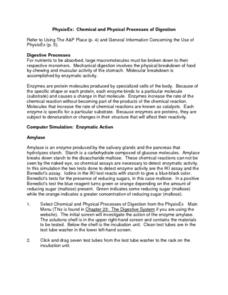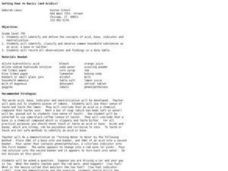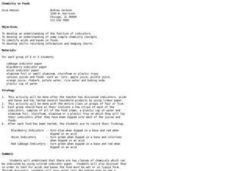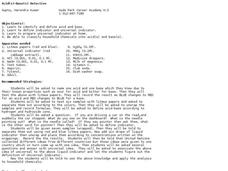Curated OER
Sometimes, solid + liquid = gas
Third graders experiment with common household liquids and solids. In this chemical reaction lesson, 3rd graders discuss phase changes and experiment to find other ways to create gases. They use water, vinegar, lemon juice, flour, baking...
Massachusetts Institute of Technology
List of Chemicals in Space
What is space made of? It turns out that there are many compounds found in space! The 10th lesson of a science series provides a list of the compounds found in space and asks young scholars to research the characteristics of these...
American Chemical Society
Different Substances React Differently
Looks don't tell the whole story. Young experimenters explore reactions with substances that look similar. They observe the reactions that take place when combined with baking soda and use indicators to conclude they react differently...
Curated OER
Chemical Changes or Reactions
In this chemical changes worksheet, students create a concept map for chemical changes or reactions. They indicate the definition, the description, they give examples and they give non-examples in a graphic organizer.
Curated OER
PhysioEx: Chemical and Physical Processes of Digestion
In this anatomy worksheet, pupils complete 22 review questions in the format of short answer, table completion, and fill in the blank after finishing an online virtual experiment about the chemical and physical processes of digestion.
University of Georgia
Endothermic and Exothermic Reactions
Equip your chemistry class with the tools to properly understand endothermic and exothermic reactions. Young chemists collect, analyze, and graph data to determine how the Law of Conservation of Matter is applied to chemical composition...
Royal Society of Chemistry
Acids and Bases—Microscale Chemistry
Here's proof that small-scale labs lead to big-time learning. Introduce acid-base interactions to middle school scientists through a microscale chemistry lab. Pupils combine a variety of solutions and use indicators to obtain approximate...
American Chemical Society
Color Changes with Acids and Bases
Getting back to the beginning of the unit, learners use reactions with red cabbage juice to determine if solutions are acidic, neutral, or basic. This is a straightforward and classic investigation, but what you will appreciate is the...
American Chemical Society
Formation of a Precipitate
Conclude this chemical change unit by having your class combine two liquids that result in formation of a precipitate. The learners discover that chemical reactions result in new materials. Make sure to consider all of the preceding...
Curated OER
Chapter 15 Review, Section 2: Acid-Base Titration and pH
Keep it simple with this chemistry assignment. Learners examine an acid-base titration graph and answer four questions about the data. Then they will balance neutralization equations and calculate molarity for several specific solutions....
Curated OER
Household Chemicals
In this chemicals worksheet, students review how to read chemical labels, define an acid-base indicator, and decide which way strong acids can be dangerous. This worksheet has 15 short answer and 20 fill in the blank questions.
Curated OER
Making A Natural pH Indicator
Students make their own pH indicator from red cabbage. Red cabbage contains a chemical that turns from its natural deep purple color to red in acids and blue in bases. Students boil the cabbage to get the pH indicator.
Curated OER
Understanding Chemical Hazard Labels and MSDS
For this chemical hazard labels and MSDS worksheet, students read and interpret chemical hazard labels and MSDS. Then they use the documents given to respond to several questions about chemical hazard labels. Students identify the...
Curated OER
Chemical Leavening Agents
Young scholars examine chemical leavening agents in dough and batters.
Curated OER
Ziplock Chemistry
Students investigate various chemical reactions when creating mixtures in ziplock baggies. In this chemistry lesson, students will recognize various chemical reactions and cite evidence. Safety and assessment strategies are included in...
Curated OER
The Heat is On!
Fifth graders investigate evidence for changes in matter that occur during a chemical reaction.
Curated OER
Stiochiometry: Quantifying Changes in the Environment
Students examine stoichiometry. For this chemical reaction and mole lesson, students complete an experiment based on readiness levels to explore that changes are quantified in chemical reactions.
Curated OER
Writing Ionic Formulas
In this ions worksheet, students use a table of common ions to determine how to write the chemical formula, using subscripts, to make a neutral compound. This worksheet has 44 problems to solve.
Curated OER
Getting Down to Basics (and Acidics)
Seventh graders investigate acids and bases. For this acids and bases lesson, 7th graders use household items such as coffee, lemons and soap to define acids and bases. They observe a demonstration to show how indicators determine if a...
Curated OER
The "Clock Reaction" Kinetics Lab
Students investigate the effects of temperature and concentration on the rate of reactions. In this "clock reaction" kinetics lesson plan, students change the concentration of one reactant and keep the second constant. An indicator is...
Curated OER
Chemistry in Foods
Students investigate foods that are indicators, and acids and bases. In this food chemistry lesson plan, students test household products with litmus paper and with food indicators. They use blackberry, onion and red cabbage indicators...
Curated OER
Acid(s)-Base(s) Detective
Students investigate acids, bases, indicators and universal indicators. In this acid and base lesson plan, students test 6 samples with litmus paper and determine if they are acids or bases. They separate out 7 samples using litmus paper...
Curated OER
Speeding up the Fizz
Students investigate temperature and chemical reactions. They explore the effect of temperature and particle size has on the rate of a simple chemical reaction. In addition, they graph their results and answer assessment questions.
Curated OER
Stomach Chemistry
Fifth graders compare physical and chemical changes. They perform a simulation experiment/activity that replicates what happens in the stomach as food is digested by stomach acids.

























